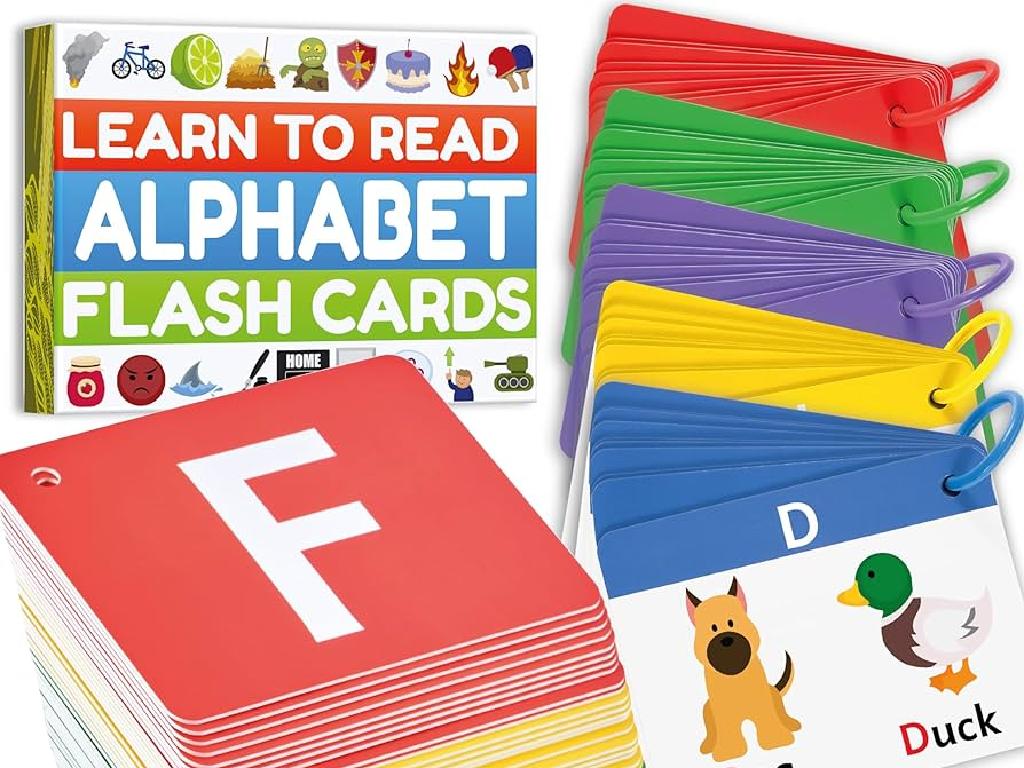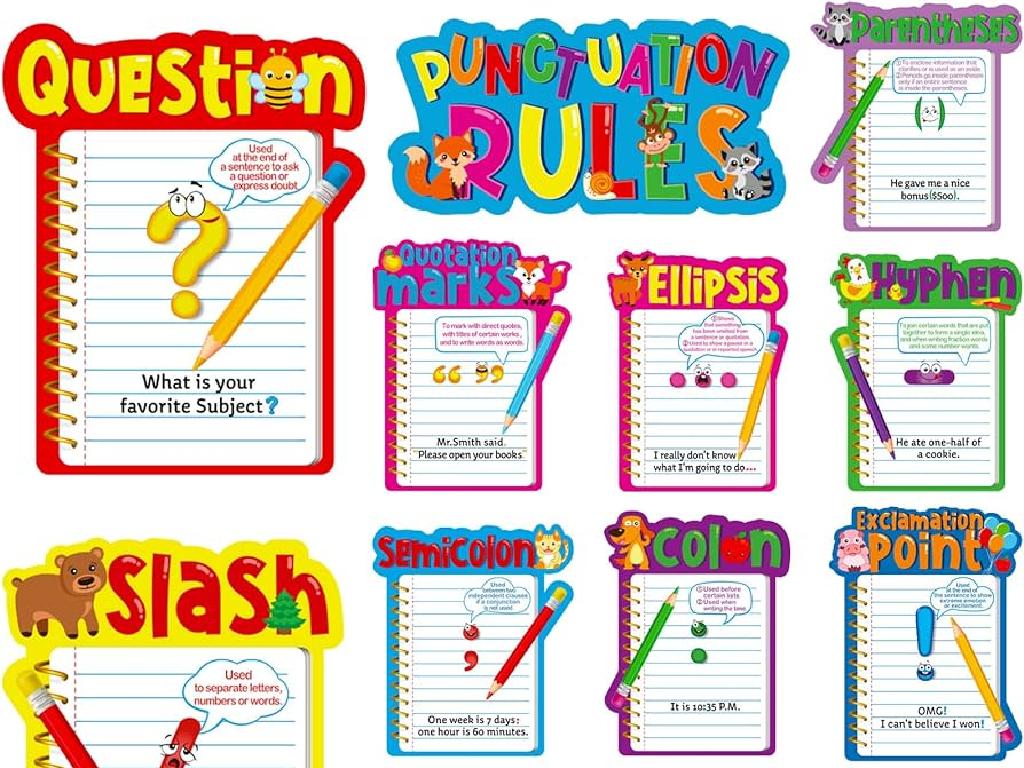Identify And Classify Fossils
Subject: Science
Grade: Fourth grade
Topic: Fossils
Please LOG IN to download the presentation. Access is available to registered users only.
View More Content
Welcome to the World of Fossils!
– What exactly are fossils?
– Fossils are remains of ancient life, like bones or shells.
– How fossils come to be
– Layers of sediment cover remains, which turn into rock over time.
– The significance of fossils
– Fossils show us what life was like long ago on Earth.
– Classifying different fossils
– We can sort fossils by size, type, or age to study them.
|
This slide introduces students to the concept of fossils, their formation, and their importance in understanding Earth’s history. Begin by explaining that fossils are the preserved remains or traces of animals, plants, and other organisms from the remote past. Highlight the process of fossilization, where remains get buried under sediment and eventually turn into rock. Discuss why fossils are crucial for scientists: they act as a historical record, helping us to understand what the world used to look like and how life has evolved over time. Finally, touch on the basics of fossil classification, which helps paleontologists organize and make sense of their findings. Encourage students to think about how a paleontologist is like a detective, piecing together clues from the past.
Exploring Types of Fossils
– Body Fossils: Preserved hard parts
– Examples: Bones, teeth, shells
– Trace Fossils: Evidence of activity
– Examples: Footprints, burrows, coprolites
– Each type reveals past life details
– Body fossils show physical structure, trace fossils show behavior
– Importance of fossil classification
|
This slide introduces students to the two main types of fossils: body and trace fossils. Body fossils include parts like bones, teeth, and shells that were once part of living organisms. Trace fossils are signs of an organism’s activities, such as footprints, burrows, and even fossilized feces (coprolites). Discuss how body fossils can tell us what creatures looked like and how they may have lived, while trace fossils provide insights into the behavior and interactions of past life. Emphasize the importance of classifying fossils to understand Earth’s history. Encourage students to think about what information each type of fossil might reveal and why both are crucial for paleontologists.
How Fossils are Formed
– Understanding fossilization
– Fossilization is how living things become preserved as fossils.
– Conditions for fossils to form
– Fossils need the right conditions, like quick burial and hard parts.
– Examples: Petrification
– Petrification happens when organic material turns into stone.
– Molds and casts
– Molds are imprints left by organisms, casts are filled-in molds.
|
This slide introduces students to the concept of fossilization, the natural process by which remains of living things are preserved over long periods. Start by explaining the conditions necessary for fossilization, such as rapid burial and the presence of hard parts like bones or shells. Discuss petrification, where organic material is replaced with minerals, turning it into stone. Provide clear examples of molds and casts, explaining that molds are the imprints left behind when the organic parts decay, and casts are created when these molds are filled with minerals or sediments. Use diagrams or images of petrified wood and fossilized shells to help students visualize the concepts. Encourage students to think of questions about how different fossils might have formed.
Fossil Hunters: Unearthing the Past
– Who are paleontologists?
– Scientists who study fossils to learn about Earth’s past.
– Tools for fossil excavation
– Brushes, chisels, and picks are some tools they use.
– Paleontologists’ role in history
– They help us understand what Earth was like long ago.
– Excavation: A careful process
|
This slide introduces students to the exciting world of paleontology. Paleontologists are scientists who study fossils to learn about the history of life on Earth. They use various tools, such as brushes to gently uncover fossils and chisels and picks to carefully extract them from rock. Their work is crucial in helping us understand the different organisms that existed millions of years ago and how they have evolved over time. Emphasize the importance of patience and precision in the excavation process. You can also discuss how paleontologists must be keen observers, piecing together clues from the past to form a clearer picture of Earth’s history.
Classifying Fossils: Body vs. Trace
– Learn criteria for fossil classification
– Hands-on activity with fossil samples
– Sort real or model fossils into body or trace categories
– Discuss characteristics of fossils
– Size, shape, and what they tell us about past life
– Understand body and trace fossils
– Body fossils are actual remains; trace fossils are activity evidence
|
This slide introduces the criteria for classifying fossils and sets up a hands-on activity for students to engage with real or model fossils. The activity involves sorting fossils into two categories: body fossils, which are the actual remains of an organism, like bones or teeth, and trace fossils, which are evidence of an organism’s activity, like footprints or burrows. Discuss with students the characteristics that help us classify fossils, such as their size, shape, and the story they tell about past life. Encourage students to think like paleontologists and use their observation skills to classify each sample. Provide a variety of samples for students to examine and classify. After the activity, facilitate a discussion on their findings and the importance of fossils in understanding Earth’s history.
Fossils Tell a Story
– Fossils as clues to rock age
– Fossils help date layers of rock, older layers lie below younger ones.
– Past environments revealed
– Fossils show what plants/animals lived, indicating climate and habitat.
– Interpreting the fossil record
– Fossil record is a history book of life, showing evolution and extinction.
– Importance of fossil classification
|
This slide introduces students to the concept that fossils are more than just remains of ancient life; they are storytellers of Earth’s history. By examining where a fossil is located in rock layers, scientists can determine the relative age of the rocks. Fossils also provide insights into what the environment was like in the past, such as whether an area was once underwater. Interpreting the fossil record helps us understand the chronological order of life on Earth and how different species have evolved or gone extinct over time. Encourage students to think of fossils as pieces of a puzzle that help us put together the picture of our planet’s history. Discuss the importance of classifying fossils to understand relationships between past and present life forms.
Class Activity: Fossil Identification
– Examine fossil samples in groups
– Classify each fossil discovered
– Present findings to the class
– Discuss fossils’ link to the past
– How do these fossils help us learn about ancient environments and life?
|
In this engaging class activity, students will work collaboratively in small groups to examine real or replica fossil samples. The goal is for them to observe, touch, and analyze the fossils to classify them based on their characteristics. After the classification, each group will prepare a short presentation to share their findings with the class, fostering public speaking and teamwork skills. Finally, lead a discussion on the significance of fossils in understanding Earth’s history, evolution, and changes in the environment. This activity will help students appreciate the role of paleontology in science. Possible activities include identifying plant vs. animal fossils, determining the era they might belong to, and hypothesizing about the environment where the organisms lived.






